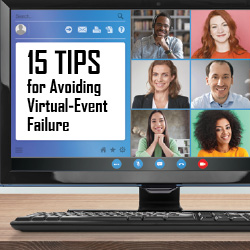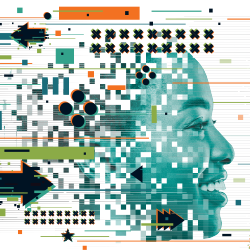|
exhibitor q&a
Help!
Prerecorded Content

ILLUSTRATION: MARK FISHER
Q.
We're planning to include a host of sessions at our digital event, and we're leaning toward prerecorded content instead of live feeds. What are the pros and cons of this option?A.
Both live and prerecorded content are equally valuable. Choosing between them comes down to your objectives and preferences for your experience as well as those of your audience. But as you make your selection, remember that "canned" doesn't have to appear flat or somehow "less than live." With the right direction and production, your videos can be shot and scripted to simulate the excitement of a live broadcast. Plus, you can post your video "simulive," which means the presentation goes live in real time, but the content was previously recorded. That said, here's an overview of the pros and cons of prerecorded content.Prerecorded Content Pros ➤ Technical glitches are minimized. One of the biggest benefits of prerecording is that you reduce your reliance on the speakers' internet connections and technology. With a live feed, you're in deep trouble if their Wi-Fi crashes, power goes out, or bandwidth dips. With canned content, you can sidestep almost all technology issues. ➤ Sessions can be edited and enhanced. Likely the most obvious advantage of recorded content is that you can go back and fix the flubs. You're able to do multiple takes to get it right, or sometimes minor missteps can be edited out. Furthermore, you can add enhancements, including everything from music to graphics, to create a more consistent and on-brand message. But if you want to support an authentic "live" vibe, you might want to lighten up on editing. That is, too much polishing to remove verbal stumbles and side comments, for example, can alter the perceived genuineness of the presentation. ➤ Speaker prep time is minimized. Speaker prep time for prerecorded sessions tends to be less than that of live feeds. During a prep session, you typically check speakers' tech setups to ensure everything is in order, and you review backgrounds, lighting, camera placement, etc. With live presentations, in addition to the aforementioned tasks, there also needs to be a comprehensive review of platform details so speakers are fully comfortable with the setup and controls, particularly since they don't have the luxury of multiple takes. With prerecorded content, you can sometimes simply prepare speakers for the first 15 to 30 minutes of a session and then go right into recording. With live, you'll likely need two or three prep sessions, which requires more time and sometimes money if you're hiring an outside agency. Prerecorded Content Cons ➤ Content can quickly become outdated. As evidenced by all of 2020, things change rapidly in our world. So even if you record footage just a week before an event, world and national events could make comments or info in your canned presentation outdated. Plus, fresh perspectives or approaches might resonate with your audience more effectively. ➤ Editing and recording usually require additional time or money. It's a vast oversimplification, but when your video is live, you point the camera and shoot, which means there's no editing or post-recording tasks to complete. The minute you turn the camera off, it's over. However, the editing and enhancement benefits of prerecording will involve additional costs in the form of your time or additional fees paid to your agency for these services. ➤ Content has to be ready much earlier to allow for post-production work. Scripts, graphics, accompanying PowerPoints, videos, etc. must be finalized much earlier in the process than they would if your speakers were going live on the day of the event. That is, for taped sessions, speakers will likely record several weeks or even months prior to your event, and their content must be ready at that point. If they're speaking live, they will likely have more time prior to the experience to prepare content. So if your pre-event production schedule is pinched, live feeds may be a better option. ➤ Scheduling can be a challenge. With a live feed, speakers commit to a specific day and time in order to participate. When they're recording their presentations, they'll likely expect some flexibility on your end in terms of scheduling. Point is, with a live feed, everyone is committed to one day and time. With recorded content, you're wrangling schedules for multiple people on multiple days and times. If you're using an agency, you're certainly getting additional value and service, but you're also adding another layer of scheduling challenges to the mix. Again, live versus recorded is all about your goals for the experience and the audience's expectations. But after weighing these pros and cons, you'll be better equipped to make that "live versus canned" decision. — Adam Sloyer, CEO and founder, Sequence Events, New York
Help Wanted Send your tough questions about exhibiting to Linda Armstrong, larmstrong@exhibitormagazine.com.
|
|
|
||||||||||||||||||||||||||||
|
|
||||||||||||||||||||||||||||
|
TOPICS Measurement & Budgeting Planning & Execution Marketing & Promotion Events & Venues Personal & Career Exhibits & Experiences International Exhibiting Resources for Rookies Research & Resources |
MAGAZINE Subscribe Today! Renew Subscription Update Address Digital Downloads Newsletters Advertise |
FIND IT Exhibit & Display Producers Products & Services All Companies Get Listed |
EXHIBITORLIVE Sessions Certification Exhibit Hall Exhibit at the Show Registration |
ETRAK Sessions Certification F.A.Q. Registration |
EDUCATION WEEK Overview Sessions Hotel Registration |
CERTIFICATION The Program Steps to Certification Faculty and Staff Enroll in CTSM Submit Quiz Answers My CTSM |
AWARDS Sizzle Awards Exhibit Design Awards Portable/Modular Awards Corporate Event Awards Centers of Excellence |
NEWS Associations/Press Awards Company News International New Products People Shows & Events Venues & Destinations EXHIBITOR News |
||||||||||||||||||||
|
||||||||||||||||||||||||||||






